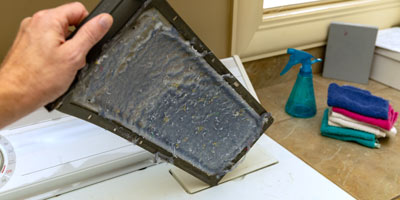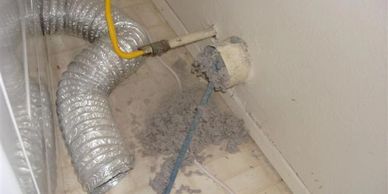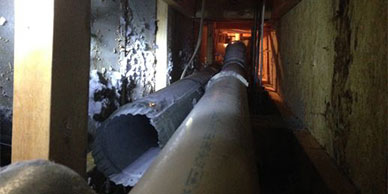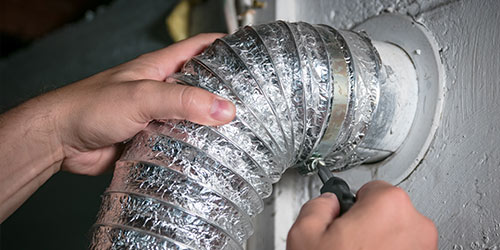Frequently Asked Questions

Doesn’t the lint screen
catch the lint?
Some dryer owners think the dryer’s lint screen captures all lint generated in the drying process. But the lint filter only captures 90-95% of the lint produced during each dry cycle. The rest bypasses the screen and adheres to the moist passageway (the lint chute, the fan assembly, the interior dryer duct, the transition vent, and finally the dryer vent/duct system leading outdoors). Restricted passageways caused by lint buildup can reduce airflow and affect dryer performance.

What happens when lint restricts airflow?
When lint builds up, it can restrict airflow. This leads to:
- Carbon monoxide back up (gas dryers only)
- Longer drying times
- Increased energy usage
- Higher operating temperatures
- Dryer component failure
- Reduced dryer lifespan
A thorough brushing of the dryer vent system, from the back of the dryer to outside the home, will remove all soft and hard lint deposits.

Can lint build up
inside the walls?
Yes! Occasionally we find that a metal 4-inch vent or duct inside the wall was not installed correctly, resulting in lint and moisture escaping the vent and adhering to walls. Warm, moist air trapped in walls creates concerns about mold. For gas dryers, there is the additional concern regarding carbon monoxide in the air stream that is not exiting the home. Our technicians can repair or install vent systems to correct this problem.

How often do dryer fires happen?
Of the 15,000 dryer-related fires that occur each year, FEMA reports that “Failure to clean is the leading contributing factor to the ignition of clothes dryer fires.”* The U.S. Fire Administration states:
“The most likely items to ignite first are clothing near the dryer, as well as dust, fiber, lint, etc. This can be any place that collects dust and lint, such as within the dryer chassis, on the lint screen, around the dryer or in the dryer duct that carries the lint from the dryer to the outside of the home.”
All dryer manufacturers, the Consumer Product Safety Commission, the National Fire Protection Association and Consumer Reports recommend regular thorough cleanings of your clothes dryer and venting system.
*FEMA – Clothes Dryer Fires in Residential Buildings 2008–2010 Volume 13, Issue 7 / August 2012).

Is my dryer venting up to code?
We inspect the entire vent system to ensure it meets code. Plastic, mylar, or collapsible foil flex hoses reduce air flow. When homeowners push the dryer into place, these non-compliant products compress to less than the 4-inch diameter required by manufacturers and local building codes. In addition, the corrugations in the material create perfect crevices for lint accumulation. Corrugated vents also cause airflow turbulence which delays the exit of moisture and lint from your home. This contributes to more rapid buildup of lint within the vent.
Plastic and collapsible foil or mylar flex vents are flammable. Homeowners should replace them with 100% metal dryer vents that maintain the required 4-inch minimum diameter when compressed or turned. Our technicians are trained to install metal vent systems that meet local building codes.

What benefits will I see from the service?
Our dryer vent cleaning process restores maximum dryer efficiency, reduces machine energy consumption, extends the lifespan of your dryer, and reduces the possibility of overheating. Our technicians clean and inspect the:
- Entire vent that leads to the exterior of the home
- Outside exhaust outlet
- Transition hose / vent
- Booster blower (if applicable)
- Lint trap housing
- Interior cabinet duct
- Interior fan blower
- Motor
- Cabinet and other components
- Floor beneath the dryer
- Wall behind the dryer
- Washer hoses

How often should I clean my dryer and dryer vents?
It’s NOT one size fits all. Most dryers and vent systems require cleaning every 1 to 5 years. Some manufacturer warranties require annual cleaning. Variables that affect cleaning requirements include:
- Manufacturer’s requirements
- Volume of laundry
- Total length of the dryer vent system
- Number of bends in the system
- Type, length, and position of the transition vent
- Pet hair or dander present
- Whether the vent or duct joints are screwed or taped together
- Location of the outside exhaust outlet
- Brand of laundry detergent used
Our technicians will assess your dryer and vent installation and advise you on the appropriate service frequency for your unique system.

How long does drying cleaning take and what will it cost?
We allot up to 90 minutes for each full-service appointment. Our fees range from $189 to $269. Fees vary depending on difficulty of installation, exterior vent location, type/brand of dryer, and location. Group Discounts are available for qualifying organizations. When completing the online request form, please ask to speak with the field manager for more details.
